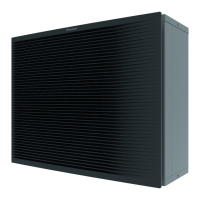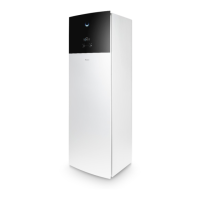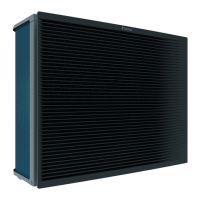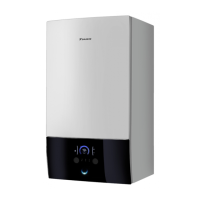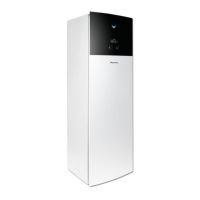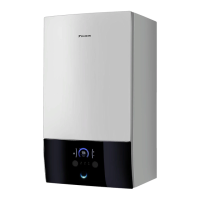3 Set-up and installation
Installation manual
20
Daikin Altherma ETS(X/H)(B)-D
Heat pump (indoor unit) with integrated heat accumulator
008.1448499_00 – 06/2019 – EN
Fig.3-30 Establishing the heating connections
▪ Install the line so that the sound insulation hood can be posi-
tioned easily after installation.
▪ For rearward facing connections: Support hydraulic lines suit-
ably according to the spatial conditions, see Fig. 3-31.
Fig.3-31 Supporting rear-facing hydraulic lines
▪ Connect the water for filling or refilling the heating system as
per EN1717 so that contamination of the drinking water due to
return flow is reliably prevented.
3 Connect the drain line to the safety overpressure valve and dia-
phragm expansion vessel as per EN12828.
▪ Check the seat of the drain hose on the pressure relief valve.
▪ If necessary, connect and install a separate hose.
4 Carefully insulate pipework against heat loss and to avoid con-
densation (insulation thickness at least 20mm).
▪ Water shortage protection: the controller's pressure and tem-
perature monitoring function reliably shuts off the Daikin
Altherma 3 H HT ECH
2
O if there is a shortage of water. No ad-
ditional water shortage protection is needed in the construction.
▪ Avoid damage caused by deposits and corrosion: see
Chap. 1.2.5
5 Connect the drain hose to the hose connecting piece for the
safety overflow (Fig. 2-3, item23).
▪ Use transparent drain hose (draining water must be visible).
▪ Connect the drain hose to an adequately dimensioned waste
water installation.
▪ Drain should not be lockable.
Fig.3-32 Installation of drain hose at safety overflow
6 Connect the discharge fitting on the cover (Fig. 2-2, item30) to
the waste water installation with the enclosed hose section.
7 Connecting a diaphragm expansion vessel (see Fig. 3-33)
▪ Connect a suitably dimensioned and preset diaphragm expan-
sion vessel for the heating system. There may not be any hy-
draulic blocking elements between the heat generator and the
safety valve.
▪ Position the diaphragm expansion vessel in an easily access-
ible place (maintenance, parts replacement)
Fig.3-33 Mounting the diaphragm expansion vessel
3.7 Electrical connection
DANGER: RISK OF ELECTROCUTION
Touching live parts can result in an electric shock and
lead to potentially fatal injuries and burns.
▪ Before beginning work on live parts, disconnect all of
the systems circuits from the power supply (switch off
external main switch, disconnect fuse) and secure
against unintentional restart.
▪ Establishment of the electrical connection and work on
electrical components should only be performed by
electrical technicians in compliance with valid stand-
ards and guidelines as well as the specifications of the
energy supply company and the instructions in this
manual.
▪ Never make constructional changes to connectors or
other electrical equipment components.
▪ Device covers and service panels must be replaced
as soon as the work is completed.

